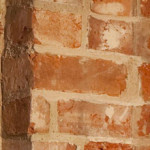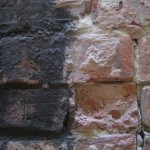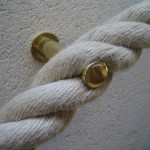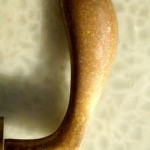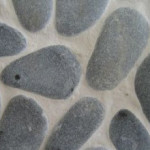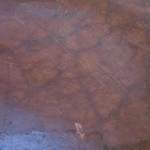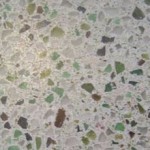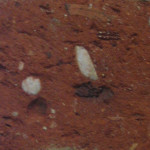We used 14 different reclaimed building materials in zero carbon house. Some are visible but many are not.
Earth block walls
We used unfired earth in a way that has not been done before in the UK.
The main load-bearing walls of house, three stories high, are made from earth blocks. Normally load-bearing walls are made from either clay bricks or concrete, but neither of these are insignificant in terms of carbon emissions. (Clay has to be fired at very high temperatures and concrete is responsible for five per cent of global CO2 emissions.)
We used earth instead. Our load-bearing walls are made from Sumatec hydraulically compressed earth blocks. These blocks are made from waste unfired clay, too earthy to be made into bricks, and have a very low embodied energy. The 140mm blocks are very dense and store heat very well. They can also help to moderate or control the internal humidity in the building and act like a natural air-conditioning system. They absorb moisture when it’s too humid and give it out again when it is too dry.
Rammed earth floors
More visibly, we have used earth for the floors throughout the house. The rammed floors undulate gently and are polished with citrus oil and beeswax, contributing to the natural light in the house. They are generally 75mm thick, laid over insulation on the ground floor and over composite timber floor structures on the upper levels. They’re made with densely compacted material from the site excavations and, with some additional clay, become very hard with age like the earth floor of an ancient barn. Earth is one of the oldest construction materials known and is still used internationally in many countries today. It also has interesting contemporary associations in the work of artists such as Richard Long.
Recycled Honeydew maple for stairs
We discovered some reclaimed 200-year-old Canadian Honeydew maple that had been the floor of a silk factory. It’s very a hard wood, but was so blackened with grime when it arrived that you couldn’t see the grain or colour of the timber. We’ve used it for all the clear-finished timber in the house. John the carpenter lovingly put it together lining up all the joints to create the fully-lined maple window seat on the top floor. Eddie of Gallande Joinery on Tindal Street constructed the gently radiating stair treads, each one different, and the tapering dining table, and used the offcuts to make our slatted kitchen shelves.
Reclaimed door handles
Our door handles are modern design classics by the celebrated Danish architect and furniture designer Arne Jacobsen. Modern architects tend to use stainless steel, sometimes unthinkingly; but the soft mottled glow of the 50 year old unlacquered brass – convex to meet the palm of the hand and concave for the thumb – adds warmth and humanity. The handles were reclaimed from another 1960s building where they would have gone into a skip. I kept one beside me as I designed the house as a reminder or icon of what the zero carbon house was all about: excellence in both design and sustainability.
Hemp stair rails
Hemp ropes are used for our stair rails and sliding door handle. Hemp is more renewable and far less energy intensive than stainless steel.
Recycled glass work surfaces
Our kitchen work surfaces are made from recycled glass supplied by Bottle Alley Glass. Glass is unique as it can be recycled indefinitely without loss of quality.
Recycled glass bathroom floors
Our bathroom floors are made from resin-bound recycled glass from bottle banks.
Reclaimed brickwork on the house front
Bricks reclaimed from a local demolished garage have been used to make the brick framing to the front of the house. They have been stack-bonded with fine 6mm joints by Gary the bricklayer to match the house next door.
Pebbles
In place of tiles, we put warm grey collected pebbles around the bath and basin splashbacks. Unlike ceramic tiles, no energy-intensive firing in kilns. And a little reminder of the seashore in the heart of the city.
You might also be interested in:
